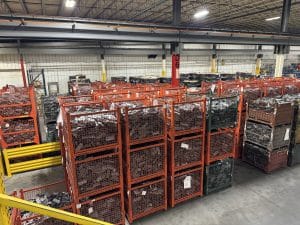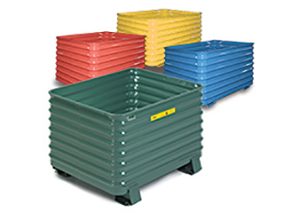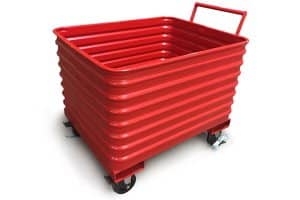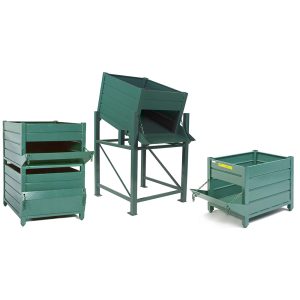Industrial Containers: The Material Handling Solution for a Variety of Applications
Manufacturers commonly use industrial containers to hold raw materials, parts and components within the material handling process. While many of those containers are in standard dimensions and capacities, companies often require customizable units for unique needs.
“Industrial containers are as customizable as need be,” says Craig Heil, Specialty Products Manager at Steel King Industries, a leading manufacturer of storage rack and material handling products. “When companies have a storage or product transit need, we can customize a solution for work-in-progress management, line feeding, kitting, finished goods storage or other applications.”
Storage and movement of scrap metals intended to be recycled is a common use but one which often is customized to match a company’s need, Heil noted. In facilities where parts are machined, fabricated, stamped or forged, metal removed during the processes is recycled. That recycling is usually managed by a third party, which places the containers in a customer’s sites and then which hauls the filled containers to a recycling center.
Recycler Appreciates Durability
 An expanding company regularly comes to Steel King for new containers when it contracts new business. The company likes the durability of Steel King’s containers, which often take a beating on the job. Depending on how they are used, steel containers can provide decades of service.
An expanding company regularly comes to Steel King for new containers when it contracts new business. The company likes the durability of Steel King’s containers, which often take a beating on the job. Depending on how they are used, steel containers can provide decades of service.
“People gravitate to steel containers because of their abuse resistance compared to that of wooden or plastic containers,” Heil says. “Steel containers are the heavy-duty solution for handling bulk materials and parts.”
Steel King’s customer in the recycling business orders containers in a 44x50x48 dimension, which is larger than the basic 32×40-inch and 40×48-inch containers available through its Quick Ship program.
The scrap metal containers the recycling company uses are fully welded on the insides, creating a sealed environment that retains liquids such as cutting oils used in machining. The containers are fitted with a valve to allow the liquids to be drained and properly handled, Heil notes.
Legs on the containers allow operators of forklifts fitted with a rotating attachment to flip the containers upside down, in order to dump the loads.
Like many of Steel King’s containers, they can be stacked for better use of floor space.
Unique Applications for Containers
Another Steel King customer required containers customized in a more rectangular shape rather than the usual square shape, to accommodate long pieces of steel. This customer – in the ship-building industry – needs containers in the dimension of 52 x 150 x 39 inches. “It’s just another example of what we can offer besides standard-size containers,” Heil says. These containers are stackable and include fork tubes, crane hooks and a removable end gate for access to the steel pieces.
More unusual is a container/rack system Steel King created for a distributor of items for retailers and restaurants. Shopping carts are among the distributor’s offerings, and that presented a unique storage challenge. In collaboration with the company, Steel King designed and manufactured a container racking system that lets the distributors store shopping carts eight deep and two-sided.
A ramp allows the carts to be pushed onto the storage unit from the floor. A movable bar and straps are used to keep the carts in place, and plastic on the container rack further protects the carts.
Fork tubes allow the storage units to be moved and stacked.
Factors in Determining Container Selection
There are several basic factors to consider when determining which type of containers will meet your material handling needs. For container construction purposes, the factors include:
- Load information
- Load weight – maximum and minimum
- The parts or loads the container will carry
- Whether the containers need to be stackable, including the ability to stack with existing containers
 For the container’s dimensions, you’ll need to identify an overall size as well as a usable-space size, figured on length x width x height.
For the container’s dimensions, you’ll need to identify an overall size as well as a usable-space size, figured on length x width x height.
Steel King’s round corner, corrugated steel containers are the most commonly used for bulk storage, with a 4,000-pound capacity and universal stacking legs. They are stackable up to four high. The corrugated design significantly enhances their strength and resistance to weight loads and environmental impacts.
For greater needs, heavy-duty containers from Steel King have a standard capacity of 6,000 pounds, and are custom designed. They can be stacked up to six high while loaded. Sides can be flat or corrugated steel, wire mesh, expanded metal, or a combination of those. The container base can be flat or corrugated steel, wire mesh, expanded metal or bar grating.
Containers for Any Need
Steel King’s container line-up also includes:
 Scrap Hoppers – with heavy-duty swivel casters and. push handle that allow easy movement, and fork tubes for quick and easy load dumping. The hoppers can hold up to 4,000 pounds and have corrugated steel sides.
Scrap Hoppers – with heavy-duty swivel casters and. push handle that allow easy movement, and fork tubes for quick and easy load dumping. The hoppers can hold up to 4,000 pounds and have corrugated steel sides.
Collapsible Steel Containers – These containers combine the cost savings of a light-duty, collapsible contained with the durability of a heavy-duty, rigid contained. Sides can be wire mesh, corrugated steel or expanded metal. When not in use, all the sides can be folded down for efficient storage.
 Workingtainers – With a door that easily opens and that serves as a parts tray, these containers are perfect for use at work stations. Built with tubular construction, they can be stacked six high when fully loaded.
Workingtainers – With a door that easily opens and that serves as a parts tray, these containers are perfect for use at work stations. Built with tubular construction, they can be stacked six high when fully loaded.
Heavy-Duty, Rigid Containers – These containers are custom designed for heavy-duty applications and have tubular construction. There are options for side and base materials, and options such as drop gates, skid bars, fork stirrups, crane hooks, runners and casters.
All the above are made in America with U.S. steel.
SOLUTIONS FOR EVERY INDUSTRY.
Questions? Contact UsContact Us ![]()


